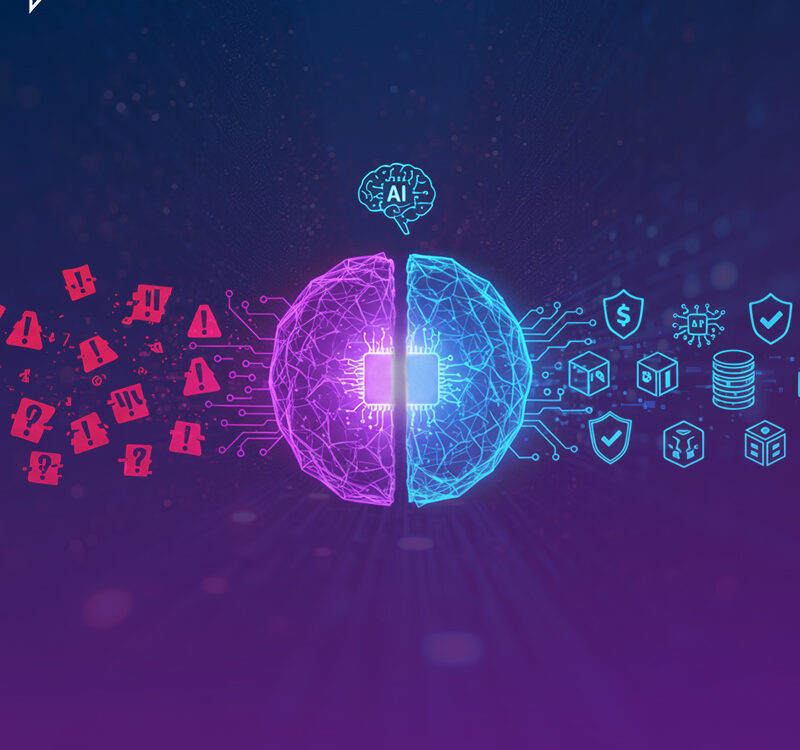September 22, 2025

Meet the World’s First Self-Evolving SOC Architecture
July 15, 2025
Why General-Purpose LLMs Fail in the SOC
August 13, 2025
Meet the World’s First Self-Evolving SOC Architecture
July 15, 2025
Why General-Purpose LLMs Fail in the SOC
August 13, 2025The Problem: SOAR Was Built for a Simpler Threat Landscape
Security teams turned to SOAR (Security Orchestration, Automation, and Response) to reduce manual effort and streamline incident response. But most quickly discovered the limitations of a system built on static playbooks and rigid workflows.
SOAR performs well in environments where processes are predictable and well-defined. But in the face of modern, multi-vector attacks — and the messy, noisy nature of real-world alert data — it breaks down.
As alert volume grows, traditional SOAR becomes harder to maintain. Each new playbook introduces more conditions, dependencies, and failure points. A missing enrichment, a novel attack technique, or even a slightly different log format can derail an entire response chain.
Worse still, SOAR assumes incident response is a deterministic, step-by-step process. But sophisticated threats don’t follow a script — they evolve, fork, loop back, and exploit context. And that’s exactly where SOAR falls apart.The Root Cause: SOAR Automates Tasks, Not Decisions
At its core, SOAR is a glorified rule engine. It executes predefined sequences — escalate, enrich, update, notify — but lacks the reasoning required to decide when, why, or whether to act.
Everything must be hard-coded in advance. If a new alert type emerges or if a correlation doesn’t match an expected pattern, SOAR can't adapt — it either fails silently or dumps the problem on a human.
Security operations aren’t just procedural. They're judgment-driven. What’s needed is not more automation — but autonomy.
SOAR performs well in environments where processes are predictable and well-defined. But in the face of modern, multi-vector attacks — and the messy, noisy nature of real-world alert data — it breaks down.
As alert volume grows, traditional SOAR becomes harder to maintain. Each new playbook introduces more conditions, dependencies, and failure points. A missing enrichment, a novel attack technique, or even a slightly different log format can derail an entire response chain.
Worse still, SOAR assumes incident response is a deterministic, step-by-step process. But sophisticated threats don’t follow a script — they evolve, fork, loop back, and exploit context. And that’s exactly where SOAR falls apart.The Root Cause: SOAR Automates Tasks, Not Decisions
At its core, SOAR is a glorified rule engine. It executes predefined sequences — escalate, enrich, update, notify — but lacks the reasoning required to decide when, why, or whether to act.
Everything must be hard-coded in advance. If a new alert type emerges or if a correlation doesn’t match an expected pattern, SOAR can't adapt — it either fails silently or dumps the problem on a human.
Security operations aren’t just procedural. They're judgment-driven. What’s needed is not more automation — but autonomy.
The Fix: Agentic Mesh
Agentic Mesh replaces the monolithic playbook model with a distributed, intelligent architecture of specialized AI agents.
Each agent:
Each agent:
- Performs a focused function (e.g. triage, correlation, enrichment, remediation).
- Exposes a clean, API-based interface.
- Makes decisions using embedded AI models or external LLMs.
- Communicates through a shared orchestration layer or message bus — not via hardwired flows.
Agents can operate independently, scale horizontally, and evolve without requiring central rewiring. This creates a modular, adaptive system that reflects how real incidents unfold.How Agentic Mesh Works (Technically)
1. Modular, Containerized Agents
Each agent in the mesh is deployed as an independent, stateless microservice. It’s designed with a focused capability — for example, classifying alerts, enriching threat context, or suggesting remediation steps.
These agents expose standardized APIs that allow SIRP (or the orchestrator) to assign them tasks. They're language-agnostic, scalable, and easy to upgrade or replace without impacting other agents.
Agents can also maintain lightweight local memory (e.g., caching recent tasks or decisions) to support short-term learning or speed up repeated logic — such as deduplicating alerts from the same source.
This architecture ensures that agents are loosely coupled, reusable, and composable across different workflows and security environments.
These agents expose standardized APIs that allow SIRP (or the orchestrator) to assign them tasks. They're language-agnostic, scalable, and easy to upgrade or replace without impacting other agents.
Agents can also maintain lightweight local memory (e.g., caching recent tasks or decisions) to support short-term learning or speed up repeated logic — such as deduplicating alerts from the same source.
This architecture ensures that agents are loosely coupled, reusable, and composable across different workflows and security environments.
2. Multi-Layered Intelligence
Each agent brings its own intelligence stack, tuned for its specific task type. This stack can combine several types of reasoning:
- Heuristics: Fast, rule-based logic for well-known patterns. For example, a triage agent might suppress alerts from whitelisted IPs or prioritize ones matching known IOCs.
- LLMs: For deeper analysis of unstructured or ambiguous data, like interpreting email headers, log messages, or alert descriptions. An LLM-powered agent might assess whether a login attempt looks suspicious based on behavioral patterns.
- Retrieval-Augmented Generation (RAG): When an agent needs context, it can query a knowledge store — such as past incidents, CVE descriptions, or analyst notes — and use that information to ground its response.
- Reinforcement Learning (OmniReflex): Over time, agents adapt based on outcome feedback. If a suggested action was reversed or flagged as ineffective by an analyst, the agent learns to adjust future decisions accordingly.
This layered intelligence allows agents to make decisions that are not only fast — but also contextually accurate and aligned with historical outcomes.
3. Mesh Coordination and Orchestration
Agents don’t trigger each other in a hardwired sequence like in traditional SOAR playbooks. Instead, they operate within a shared orchestration layer — the "mesh" itself.
This layer performs several core functions:
This layer performs several core functions:
- Maintains incident state: Tracks the status, context, and metadata of each alert or incident, so agents have a shared understanding of the environment.
- Routes tasks dynamically: Based on incident progression and agent outcomes, the mesh determines which agent should act next — and with what data.
- Handles fallbacks and retries: If one agent cannot complete its task (e.g., due to missing data or low confidence), the mesh can reroute the task to another agent or request human input.
This decentralized coordination mimics how experienced SOC analysts work: autonomously, in parallel, but with shared awareness and collaboration. The result is an adaptive, resilient, and scalable security brain.
Real-World Example: From Alert to Action
Real-World Example: From Alert to Action
A phishing alert enters the system.
- Triage Agent classifies it as “high confidence phishing” based on header analysis and user history.
- Context Agent pulls associated login attempts, known threat actors, and asset risk profile.
- Correlation Agent links it to a related campaign seen last week in a different business unit.
- Response Agent recommends user isolation + email purging + user awareness workflow.
- Decision Agent validates that this matches past successful response patterns and executes autonomously.
All within 30 seconds.
No playbook. No human bottlenecks. No rigid flows.
No playbook. No human bottlenecks. No rigid flows.
Why Agentic Mesh Scales Where SOAR Cracks
- MTTD Drops Alerts are triaged within seconds — without relying on rigid rules or analyst queues.
- MTTR Shrinks Context is pulled automatically. Decision paths are executed end-to-end, autonomously when safe.
- Noise Reduction Agents suppress low-confidence or low-impact alerts using historical and org-specific context.
- Analyst Focus Improves Analysts are no longer stuck sorting alerts — they handle exceptions, review decisions, and improve agent training.
Final Word: Playbooks Are for What You Already Know
If you’re still manually updating SOAR playbooks, you’re trying to fight dynamic threats with static tools.
Agentic Mesh is built for the unknown.
It doesn’t just automate tasks — it learns, reasons, collaborates, and adapts. It gives you:
Agentic Mesh is built for the unknown.
It doesn’t just automate tasks — it learns, reasons, collaborates, and adapts. It gives you:
- Distributed intelligence.
- Autonomous decision-making.
- Resilient coordination.
- And a path to a self-healing, self-scaling SOC.
SOAR was the first step.
Agentic Mesh is the leap.
Agentic Mesh is the leap.




